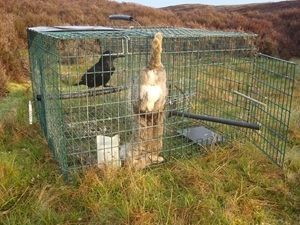 Larsen traps do catch crows, magpies and other corvids when used with bait and no call-bird. You may need several traps to be sure of success and the strategy is rather different from the call-bird approach. Without the ability to get a decoy bird from someone else who already has a spare bird (perhaps from aviary stock) the only option is to use bait to make the first capture when your trapping season starts.
Larsen traps do catch crows, magpies and other corvids when used with bait and no call-bird. You may need several traps to be sure of success and the strategy is rather different from the call-bird approach. Without the ability to get a decoy bird from someone else who already has a spare bird (perhaps from aviary stock) the only option is to use bait to make the first capture when your trapping season starts.
Where to put the trap
Although the trap should be obvious, birds will be more wary of it when there is no call-bird. So it is probably unwise to stand it out in the open. Put it among bushes, or at the base of a hedge or tree.
In contrast to using call-birds, it may take a while for your bait to be spotted (because it doesn’t move), or for birds to overcome their natural fear of novel objects (placing the trap in a livestock farm yard may reduce the time taken to catch the first bird). So anticipate quite a long effort but do check your traps daily. Pre-baiting (with the trap unset) is completely unnecessary – if a bird goes in, you might as well catch it.
If your trap catches nothing at first, don’t blame the trap. It is probable that no corvids have found your bait, (after all, many natural bird nests escape predation). After 10 to 14 days without success, it may be best to move the trap to try another site.
What bait?
The bait most likely to achieve success is probably the one the birds in the local area are familiar with and switched on to. Therefore, be mindful that seasonal variations are likely to apply and there is some evidence to suggest that effective spring and summer baits, such as eggs, are less effective outside of the nesting season.
Outside of the spring and summer, meat baits comprised of healthy fallen wildlife (livestock use is prohibited) or other recognisable food items may be the best option. Of the meat baits, open rabbits or grey squirrels have been found to be very effective, and it is the freshly glistening viscera that attracts corvids. Both crows and magpies have limited powers of opening carcasses, so this presents an easy option for them. Be aware that meat baits may increase the risk of non-target capture of species such as buzzards. If persistent problems are encountered, then a change in approach to non-meat baits is a responsible move.
Of the non-meat options, white bread can be used: it is eye-catching, fairly common in the countryside, and corvids develop a taste for it. Again, a scattering of bait is more noticeable, but don’t overdo it, or the birds will see no reason to enter the trap.
During the nesting season the best bait by far is the egg. When using them, aim to make the offering look like a depredated nest. Make a ‘nest’ of dead grass in one (only one) of the catching compartments and arrange a clutch of five or six eggs in it. Cracked or oversize gamebird eggs from the laying pen are ideal, but hens’ eggs (brown or white) seem just as attractive. Break two or three eggs around the trap, and leave the eggshells lying about. Most importantly, on the flat board that shelters the call-bird when present, or on the flat top between the two catching compartments, carefully break an egg so that the contents lie in a tempting puddle. Renew this egg regularly: it is the glistening fresh egg that catches the corvid eye.
Of other baits, carrion is second best (open rabbits or squirrels – again, it is the freshly glistening viscera that attracts, and both crows and magpies have limited powers of opening carcasses). Even white sliced bread may be used: it is eye-catching, fairly natural in farmland, and corvids develop a taste for it. Again, a scatter of bait is more eye-catching, but don’t overdo it, or the birds will see no reason to enter the trap.
Meat bait is permitted following the 2020 General Licence review for use in Larsen Mates and Pods. Operators intending to use meat bait in Larsen mate and Larsen pod traps must register with NatureScot in advance. Use of these baits is only permitted once the receipt of the appropriate information has been acknowledged by NatureScot.
Download Larsen Trap Guide >